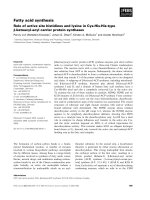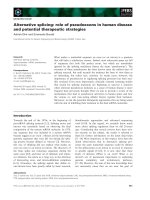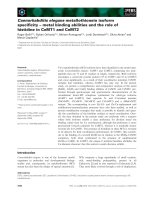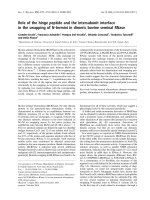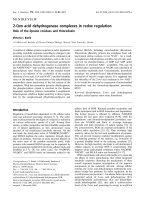ROLE OF RAP1 IN ANGIOGENESIS AND TUMOR INVASION
Bạn đang xem bản rút gọn của tài liệu. Xem và tải ngay bản đầy đủ của tài liệu tại đây (5.67 MB, 155 trang )
ROLE OF RAP1 IN ANGIOGENESIS AND TUMOR INVASION
Jingliang Yan
Submitted to the faculty of the University Graduate School
in partial fulfillment of the requirements
for the degree
Doctor of Philosophy
in the Department of Biochemistry and Molecular Biology
Indiana University
August 2009
ii
Accepted by the Faculty of Indiana University, in partial
fulfillment of the requirements for the degree of Doctor of Philosophy.
____________________________
Lawrence A. Quilliam, Ph.D., Chair
____________________________
Simon J. Atkinson, Ph.D.
____________________________
David A. Ingram, Jr., M.D.
Doctoral Committee
____________________________
Fredrick M. Pavalko, Ph.D.
June 26
th
, 2009
____________________________
Weinian Shou, Ph.D.
____________________________
Mervin C. Yoder, Jr., M.D.
iii
Dedication
I dedicate my thesis solely to my mother, Aihua Yuan.
iv
Acknowledgements
First of all, I would like to express my foremost gratitude to my advisor, Dr.
Lawrence Quilliam. He led me into the field of science, taught me the essential
attributes of a good scientist with examples, and guided me through the past five
years I spent in the lab. Lawrence has given his full support to all my activities,
be it my scientific endeavor or career pursuit. The graduate study is not always
smooth, and there have been moments when things went awfully wrong. Like a
father, Lawrence provided his support, encouragement, and his own experience
to lead me out of the shadow. He has cast significant influence on the way I think,
the way I work, and the way I view the world.
I also feel extremely fortunate to be able to have Dr. Simon Atkinson, Dr.
David Ingram, Dr. Fredrick Pavalko, Dr. Weinian Shou, and Dr. Mervin Yoder as
my committee members. Although their styles of teaching are different, they
share the same passion, rigor, and wisdom in the realm of science. Without their
scientific advice and technical assistance, my project would not have gone so far.
Five years is not enough time to absorb what they have offered, and it is my
absolute loss not to be able to learn under their direct guidance. I can only hope
that, at one day, I could turn into a scientist as good as they are.
I especially want to thank Dr. David Ingram who through his effort and
mentoring opened a door for me in medicine, and shaped my future career
enormously; and Dr. Weinian Shou who has given me firm support during the
process.
v
I am grateful to the past and current members of the lab: Dr. Hui Zong, Dr.
Yu Li, Dr. Samantha Anderson, Dr. Sirisha Asuri, Linda Flint, Justin Babcock, Li
Fan, Hoa Nguyen, and Yujun He, who made the lab a cooperative and friendly
environment. The every day I spent in lab is enjoyable, not only because of the
interesting project I work on, but also because of my fun colleagues to interact
with. Justin Babcock, my good friend, roommate and labmate, is always there to
share my joy and sadness, and to offer his help. I sincerely thank him, and wish
him all the best.
The thesis presented here is a collective work from all the people who
have contributed tremendously. I must acknowledge Dr. Hanying Chen from Dr.
Weinian Shous lab, Li Fang from Dr. David Ingrams lab, Dr. Veerendra
Munugalavadla from Dr. Reuben Kapurs lab for their exceptional help with my
experiments.
Finally, I want to thank the Department of Biochemistry and Molecular
Biology for providing a superb administrative assistance, Indiana University for
supporting all the scientific activities on campus, and American Heart Association
for awarding the pre-doctoral fellowship that funds my research.
vi
Abstract
Jingliang Yan
ROLE OF RAP1 IN ANGIOGENESIS AND TUMOR INVASION
Rap1a and Rap1b are two closely related members of the Ras family of
small GTPase. Despite their high sequence similarity, the two proteins serve non-
redundant functions in cells and organs. Rap1a plays critical roles during mouse
development, and both Rap1a and Rap1b are required for angiogenesis. In
glioblastoma cells, however, Rap1b plays a more unique role in tumor cell
invasion.
Loss of
rap1a
in mice resulted in 40% embryonic lethality, and caused
cardiac defects in mouse embryos and cardiac hypertrophy in adult mice. These
phenotypes, distinct from those of the
rap1b
knockout mice, suggest differential
roles of the two GTPases during mouse development.
Angiogenesis, the formation of new blood vessels by endothelial cells, is
impaired by the loss of
rap1
. Blood vessel growth into FGF2-containing Matrigel
plugs was absent from
rap1a
-/-
mice and aortic rings derived from
rap1a
-/-
mice
failed to sprout primitive endothelial tubes in response to FGF2 when embedded
in Matrigel. Knocking down either
rap1a
or
rap1b
in human micro-vascular
endothelial cells (HMVECs) confirmed that Rap1 plays key roles in endothelial
cell function. The knockdown of
rap1a
or
1b
resulted in decreased adhesion to
extracellular matrices and impaired cell migration. Rap1 deficient endothelial cells
failed to form 3-D tubular structures when plated on Matrigel
in vitro
. The
vii
activation of ERK, p38, and Rac, important signaling molecules in angiogenesis,
were all reduced in response to FGF2 when either Rap1 protein was depleted.
In U373 human glioblastoma multiform cells, depletion of
rap1b
, but not
rap1a
drastically reduced tumor cell invasion by decreasing the activity of
secreted matrix metalloproteinase 2 (MMP2). The adhesion of cells to the
extracellular matrices collagen or fibronectin, but not to vitronectin, was
decreased upon
rap1b
depletion. However, a mild increase in proliferation
associated with elevation in ERK1/2, p38, Akt and ribosomal S6 protein activation
was observed in cells depleted of either
rap1a
or
rap1b
. When an MEK1/2
inhibitor U0126 was used, the phosphorylation of p38, Akt and S6 were
decreased, however, to various levels, suggesting complex regulatory pathways
mediate Rap1 action in glioblastoma cells.
Lawrence A. Quilliam, Ph.D., Chair
viii
Table of Contents
List of Figures xiii
List of Abbreviations xvi
INTRODUCTION 1
1. Ras family of small GTPase 1
1.1. Rap1 small GTPase 2
1.2. Rap1a and Rap1b 3
1.3. Downstream pathways of Rap1 signaling 4
1.3.1. Mitogen activated protein kinase (MAPK) 4
1.3.2. RAPL and integrins 6
1.3.3. Rac small GTPase 7
1.4. Rap1 GEFs and cell surface receptors 8
2. Angiogenesis 10
2.1. Endothelial cells 11
2.2. Growth factor regulation of endothelial cell functions during
angiogenesis 12
2.3. Rap1 and endothelial cells 13
3. Rap1 and tumors 14
3.1. Rap1 and tumorigenesis 14
3.2. Rap1 and tumor invasion and metastasis 15
3.3. Rap1 and brain tumors 16
3.3.1. Brain tumor overview 16
ix
3.3.2. Rap1 and glioblastoma 17
RESEARCH OBJECTIVES 19
MATERIALS AND METHODS 21
1. Animals 21
2.
In vivo
Matrigel plug assay 21
3.
Ex vivo
mouse aortic ring assay 22
4. Generation of Rap1b anti-serum 23
5. Cell culture 23
6. Generation and immortalization of mouse embryonic fibroblasts 24
7. Isolation of mouse macrophages 24
8. Digestion of mouse digits and genotyping by PCR 25
9. Transfection of siRNA 26
10. Western blot 26
11. Small GTPase activation assays 27
11.1. Rap1 activation assay 27
11.2. Rac activation assay 27
11.3. Ras activation assay 28
12. Transwell chemotaxis assay 28
13. Wound-healing assay 29
14. Adhesion assay 29
15. Transwell permeability assay 30
16.
In vitro
endothelial tube formation assay 30
x
17. Proliferation assay 31
18.
In vitro
invasion assay 31
19.
In vitro
MMP activity assay 32
20. Statistical analysis 33
RESULTS 34
Chapter 1: Rap1a small GTPase plays important roles in mouse
development 34
Chapter 2: Rap1a and Rap1b are both required for endothelial cell
functions during angiogenesis 36
2.1. Rap1a null mice had defective angiogenesis stimulated by FGF2 36
2.2. Endothelial cells deficient of either Rap1a or Rap1b had altered cellular
behavior 38
2.2.1. Rap1a or Rap1b depletion impaired endothelial monolayer integrity 38
2.2.2. Rap1a or Rap1b depletion decreased endothelial cell adhesion and
migration 39
2.2.3. Decreased cellular proliferation in endothelial cells depleted of Rap1a or
Rap1b 40
2.2.4. Knocking down Rap1a or Rap1b abolished endothelial tubule
formation 41
2.3. Rap1 mediated important cellular signaling in response to FGF2 in
endothelial cells 42
2.3.1. Rap1 was activated by FGF2 in endothelial cells 42
xi
2.3.2. Rac activation by FGF2 was abolished in endothelial cells depleted of
Rap1 42
2.3.3. MAPKs phosphorylation was reduced by Rap1 knockdown 43
Chapter 3: Rap1 regulates glioblastoma malignancy 45
3.1. Loss of Rap1b induced morphological changes in glioblastoma cells 45
3.2. Reduced invasiveness of glioblastoma cell depleted of Rap1b 46
3.3. MMP production was decreased with loss of Rap1 47
3.4. U373 migration was not affected by the loss of either Rap1 48
3.5. Rap1 antagonizes Akt, S6 and p38 phosphorylation through inhibition of
ERK 49
DISCUSSION 52
Chapter 1: Rap1a small GTPase plays important roles in mouse
development 52
Chapter 2: Rap1a and Rap1b are both required for endothelial cell
functions during angiogenesis 55
2.1. The requirement of Rap1a during angiogenesis and developmental
vasculogenesis 55
2.2. Rap1 regulates endothelial cell functions during angiogenesis 57
2.3. Rap1 is a novel mediator of FGF signaling in endothelial cells 62
Chapter 3: Rap1 regulates glioblastoma malignancy 65
3.1. Rap1 activity and glioblastoma malignancy 65
3.2. Rap1 antagonizes multiple signaling pathways in glioblastoma cells 69
xii
3.3. The differential roles of Rap1a and Rap1b in regulating glioblastoma cell
invasion and biology 73
FUTURE DIRECTIONS 75
REFERENCES 117
CURRICULUM VITAE
xiii
List of Figures
Introduction
Figure 1. Sequence alignment of Rap1a and Rap1b proteins 3
Results
Figure 1-1. Mouse embryonic fibroblast and macrophage adhesion to
various surfaces 79
Figure 1-2.
rap1a
-/-
mice suffered from embryonic edema 80
Figure 1-3.
rap1a
-/-
embryos manifested various developmental cardiac
defects 81
Figure 1-4.
rap1a
-/-
mice had higher heart-to-body weight ratio than wild
type mice 82
Figure 2-1. VEGF alone did not strongly induce angiogenesis in mouse
Matrigel plug assay 83
Figure 2-2.
rap1a
knockout mouse had impaired angiogenic response to
FGF2 84
Figure 2-3.
rap1a
null mouse aortic rings had impaired tube outgrowth in
response to FGF2 86
Figure 2-4. siRNAs selectively knocked down endogenous Rap1a or Rap1b
expression in human micro-vascular endothelial cells (HMVECs)
and exogenous Rap1a or Rap1b in 293T cells 87
Figure 2-5. Knock down of Rap1 expression increased HMVEC junction
permeability 89
xiv
Figure 2-6. Suppressing Rap1 expression decreased HMVEC chemotaxis to
FGF2 and wound-healing migration 90
Figure 2-7. Suppressing Rap1 expression decreased HMVEC adhesion to
extracellular matrix proteins 92
Figure 2-8. Loss of Rap1 decreased HMVEC proliferation 93
Figure 2-9. Reducing Rap1 expression abolished HMVEC tube formation on
Matrigel 94
Figure 2-10. Rap1 was activated by FGF2 in endothelial cells 95
Figure 2-11. Rap1 depletion abolished Rac activation in HMVECs 96
Figure 2-12. Rap1 mediated ERK1/2 activation by FGF2 in HMVECs 97
Figure 2-13. Rap1 did not mediate ERK1/2 activation by VEGF in HMVECs 98
Figure 2-14. Rap1 mediated p38 activation by FGF2 in HMVECs 99
Figure 2-15. FGF2 did not mediate Pyk2 activation in HMVECs 100
Figure 3-1. Loss of Rap1b induced morphological changes in U373
glioblastoma cells 101
Figure 3-2.
rap1
shRNAs induced similar morphological changes in U373
cells 103
Figure 3-3. Rap1b depletion reduced glioblastoma cell invasion in vitro 105
Figure 3-4. Loss of Rap1 decreased the activity of secreted MMP2 in U373
cells 106
Figure 3-5. Suppressing Rap1b expression decreased U373 adhesion to
collagen and fibronectin, but not to vitronectin 107
xv
Figure 3-6. FBS and EGF stimulation activated Rap1 in U373 cells 108
Figure 3-7. U373 cell chemotaxis to FBS was not affected by
rap1
knockdown 109
Figure 3-8. U373 cell wound-healing migration was decreased by
rap1
depletion 111
Figure 3-9. Suppression of Rap1 expression increased Akt, ERK, S6 and
p38 phosphorylation stimulated by 2% FBS 112
Figure 3-10. ERK inhibition decreased Akt, S6 and p38 phosphorylation
induced by Rap1 depletion 114
Discussion
Figure D-1. Rap1b expression levels were elevated in
rap1a
null
neutrophils 115
Figure D-2. Rap1b depletion increased glioblastoma cell proliferation 116
xvi
List of Abbreviations
8Cpt-cAMP 8-(4-chloro-phenylthio)-2-O-methyladenosine-3, 5-cyclic
monophosphate
AJ Adherens junction
AR Adrenergic receptor
C3G Crk SH3 domain binding GEF
cAMP Cyclic adenosine 3, 5-monophosphate
CAPRI Ca
2+
-promoted Ras inactivator
cDNA Complementary deoxyribonucleic acid
CKI Casein kinase I
CNS Central nervous system
DAG Diacylglycerol
DTT Dithiothreitol
E6TP1 E6-targeted protein 1
EGF Epidermal growth factor
EGFR Epidermal growth factor receptor
Epac Exchange proteins directly activated by cyclic AMP
EPC Endothelial progenitor cell
ERK Extracellular signal regulated protein kinase
FAK Focal adhesion kinase
FBS Fetal bovine serum
FGF Fibroblast growth factor
xvii
FGFR Fibroblast growth factor receptor
FRS Fibroblast growth factor receptor substrate
GAP GTPase activating protein
GAPDH Glyceraldehyde 3-phosphate dehydrogenase
GBM Glioblastoma multiforme
GDP Guanosine 5-diphosphate
GEF Guanine nucleotide exchange factor
GPCR G-protein coupled receptor
GRP Ras guanine-nucleotide releasing peptide
GST Glutathione S-transferase
GTP Guanosine 5-triphosphate
HA Hemaglutinin
HAEC Human aortic endothelial cell
hCML Human chronic myeloid leukemia
HGF Hepatocyte growth factor
HMVEC Human micro-vascular endothelial cell
HSPG Heparan-sulfate proteoglycan
HUVEC Human umbilical vascular endothelial cell
ICAM Intracellular adhesion molecule-1
IP3 Inositol 1,4,5-trisphosphate
JNK c-jun N-terminal kinase
KO Knockout
xviii
LFA Lymphocyte function associated
LPA Lysophosphatidic acid
MAPK Mitogen activated protein kinase
MAPKK MAPK kinase
MAPKKK MAPK kinase kinase
MEF Mouse embryonic fibroblast
MEK MAPK/ERK kinase
MMP Matrix metalloproteinase
mTOR Mammalian target of Rapamycin
PAGE Polyacrylamide gel electrophoresis
PAK p21 activating kinase
PCR Polymerase chain reaction
PDGF Platelet-derived growth factor
PDZ PSD95/Dgl/ZO-1 domain
PECAM Platelet endothelial cell adhesion molecule
PI3K Phosphatidylinositol 3-kinase
PIP2 Phosphatidylinositol 4,5-bisphosphate
PKA Protein kinase A
PLC Phospholipase C
PMSF Phenylmethylsulfonyl fluoride
PTEN Phosphatase and tensin homolog
RA Ras association domain
xix
RalGDS Ral guanine nucleotide dissociation stimulator
RAPL Regulator of adhesion and polarization enriched in lymphocytes
RBD Ras binding domain
Riam Rap1-GTP-interacting adaptor molecule
RSK Ribosomal S6 kinase
RTK Receptor tyrosine kinase
SAPK Stress activated protein kinase
SDS Sodium dodecylsulfate
SH2 Src homology 2
SH3 Src homology 3
shRNA Small hairpin ribonucleic acid
siRNA Small interference ribonucleic acid
TIMP Tissue inhibitors of metalloproteinase
TER Transendothelial resistance
uPA Urokinase-type plasminogen activator
VEGF Vascular endothelial growth factor
VEGFR Vascular endothelial growth factor receptor
vSMC Vascular smooth muscle cell
vWF Von Willebrand factor
WT Wild type
1
INTRODUCTION
1. Ras family of small GTPases
The Ras family of GTPases are G proteins with molecular weights of
20~25 kDa. They cycle between GDP-bound inactive and GTP-bound active
forms. In their resting state, these small GTPases are associated with GDP.
Upon cellular stimulation, guanine-nucleotide exchange factors (GEFs) replace
the GDP with GTP, triggering a conformational change in the switch 1 and switch
2 domains of Ras proteins. This allows for the binding and subsequent activation
of downstream effectors. Once the signal is transduced, the bound GTP is rapidly
hydrolyzed back to GDP with the help of GTPase activating proteins (GAPs), as
the intrinsic GTPase activity of Ras proteins is very weak (1). Due to this unique
cycling, these small GTPases serve as molecular switches in the cell and are
central hubs of signal transduction, governing a myriad of cellular functions
ranging from cell proliferation, differentiation, apoptosis, to cell adhesion,
migration and morphological changes. Aberrant Ras protein activities are present
in a variety of diseases, including cancer (2) and cardiovascular diseases (3),
and therefore, the study of the role of each Ras protein in different cell types and
disease settings will greatly aid us in the understanding of the biology, the
pathogenesis and the therapeutic treatment.
2
1.1. Rap1 small GTPase
Rap1 is the most related GTPase to Ras with about 50% sequence
identity (4). It has a virtually identical effector binding domain to Ras, thus can
bind to many of the same effectors. Historically, Rap1 was independently
discovered as a Ras related cDNA (Ras proximate) (4) and as K-rev1 (Ki-Ras
revertant) to be able to reverse the Ras transformation in fibroblasts (5). It binds
tightly to c-Raf-1, a Ras effector, but lacks the ability to activate it, therefore
depleting the available pool of Raf-1 for Ras (6). Later research revealed that
Rap1 can activate B-Raf to promote MAPK activation and mimic the effect of Ras
(7). To date, after extensive studies, many important cellular processes have
been accredited to the indispensable functions of Rap1, and it therefore has
emerged as a critical cellular signaling mediator. Rap1 has been shown to
activate Akt through PI3K in thyroid cells, B and T cells (8-12); to regulate Rac
activity and cytoskeletal structures (13); and to promote integrin activation via an
“inside-out” signaling mechanism in almost all cell types (14). Rap1 has been
found in the Golgi (15), lysosomal vesicles (16), perinuclear structures (17),
nucleus (18, 19), endosomes (20), the plasma membrane (21), and epithelial
cell-cell junctions (22). This widespread distribution of Rap1 in part dictates its
diverse functions in the cell.
3
1.2. Rap1a and Rap1b
The Rap1 family consists of two proteins, Rap1a and Rap1b. They share
95% sequence identity, but are encoded by different genes (23). The main
difference lies in their C-termini (Figure 1). Whether or not these two family
members serve redundant or distinct functions is still in debate. Both
rap1a
and
rap1b
knockout mice suffer only partial lethality (~40% for
rap1a
-/-
and ~85% for
rap1b
-/-
), suggesting they could partially compensate for the loss of each other.
The attempt to create
rap1a
and
rap1b
double knockout mice also failed. On the
other hand, the
rap1a
-/-
mice had defective myeloid cell functions not seen in the
rap1b
null mice (24), and the
rap1b
knockout mice have a unique bleeding
disorder due to platelet defect (25), pointing to the distinctive responsibilities
Rap1a and 1b may carry. At the cellular level, in epithelial cells, Rap1a and 1b
Rap1a MREYKLVVLGSGGVGKSALTVQFVQGIFVEKYDPTIEDSYRKQVEV 46
Rap1b MREYKLVVLGSGGVGKSALTVQFVQGIFVEKYDPTIEDSYRKQVEV 46
Rap1a DCQQCMLEILDTAGTEQFTAMRDLYMKNGQGFALVYSITAQSTFND 92
Rap1b DAQQCMLEILDTAGTEQFTAMRDLYMKNGQGFALVYSITAQSTFND 92
Rap1a LQDLREQILRVKDTEDVPMILVGNKCDLEDERVVGKEQGQNLARQW 138
Rap1b LQDLREQILRVKDTDDVPMILVGNKCDLEDERVVGKEQGQNLARQW 138
Rap1a CNCAFLESSAKSKINVNEIFYDLVRQINRKTPVEKKKPKKKSCLLL 184
Rap1b NNCAFLESSAKSKINVNEIFYDLVRQINRKTPVPGKARKKSSCQLL 184
Figure 1. Sequence alignment of Rap1a and Rap1b proteins.
4
also seem to perform different roles. Both Rap1a and Rap1b participate in
epithelial cell junction formation, however, Rap1a is required for junction
maturation while Rap1b controls the expression of E-cadherin (26). During cell
migration, Rap1a but not Rap1b depletion resulted in decreased 1 integrin
production and reduced cell migration (27). These data suggest that the two
closely related Rap1 family members have individual functions, but could also be
due to differential expression profiles in various cell types.
1.3. Downstream pathways of Rap1 signaling
GTP loaded Rap1 activates many signaling pathways through its effectors,
which include PLC, PI3K, Raf, Ral-GDS, RAPL and Riam. These effectors can
then propagate signals to regulate: Raf/ERK pathway which modulates a wide
array of cellular functions; RAPL and Riam which promote integrin activation, cell
adhesion and migration; and another small GTPase Rac which controls actin
cytoskeleton rearrangement and cell morphology.
1.3.1. Mitogen activated protein kinase (MAPK)
Mitogen activated protein kinases (MAPKs) are important signaling
molecules in cells that transduce signals from the extracellular environment.
These proteins include extracellular signal regulated kinase (ERK), p38 and c-jun
N-terminal kinase (JNK). The MAP kinase signaling cascades are characterized
by their linear activation. They are activated by phosphorylations on conserved
5
Ser/Tyr residues by specific MAP kinase kinases (MAPKKs or MEKs). MAPKKs
are also regulated in such a way by MAP kinase kinase kinases (MAPKKKs)
(28). The most extensively researched MAPK are ERK1/2 (p44/p42) that are
activated by a Raf-MEK-ERK cascade. Upon its activation, it can regulate a wide
variety of cellular functions, including survival, proliferation, protein expression,
cell cycle control, and migration (29).
As discussed earlier, the first linkage between Rap1 and MAPKs was
established upon the discovery of Rap1. It can bind with high affinity to Raf-1, a
MEKK for ERK, but not activate it. But later research revealed that in cell types
that express B-Raf, Rap1 could also activate ERK and lead to various cellular
outcomes. For instance, in megakaryocytes, Rap1 drives a sustained ERK
activation, which is required for differentiation (30, 31). In astrocytes, Rap1 also
induced ERK phosphorylation in response to thrombin stimulation to promote
proliferation (32).
Besides ERK, another MAPK p38 has also been shown to be regulated by
Rap1. Originally named SAPK (stress activated protein kinase), p38 mostly
imposes negative regulation on cell proliferation and survival, and maintains
homeostasis (33). In certain cases, activation of Rap1 could lead to p38
phosphorylation, and can exert growth inhibitory and pro-apoptotic effects (34),
regulates neuronal synaptic plasticity (35, 36), or modulates muscle cell
stretching (37).
6
1.3.2. RAPL and integrins
Integrins are cell-surface receptors that bind extracellular matrix proteins,
and are involved in cell adhesion, migration, and basement membrane
rearrangements (38). They are composed of and subunits that are non-
covalently associated together. Upon stimulation, intracellular signals direct the
assembly of a protein complex at the cytoplasmic tail of integrins, which then
promotes the extension of integrins to their active conformations. Since the
information comes from inside the cell, this process is often referred to as “inside-
out” signaling.
Once integrins make contact with extracellular matrix proteins, to bind
tightly with the ECM, the cell also has to respond to the initial attachment. The
cytoplasmic portions of integrins will need to cluster together, and anchor onto
the cytoskeleton. This structure is known as the focal adhesion (39). Therefore,
integrin signaling is bidirectional, both from inside-out and from outside-in. This
process is likely to involve the regulation by many different proteins.
Rap1 has been implicated as a major regulator of integrin activation
through its downstream effectors, Riam and/or RAPL. Overexpression of Riam in
T cells led to
1
and
2
integrins activation, the same effect as the expression of
constitutively active Rap1 (40). The activation of platelet integrins,
IIb
3
, also
requires the presence of Riam (41). Another Rap1 effector, RAPL, is required for
LFA binding to ICAM-1 in lymphocytes (42). It also colocalizes with active Rap1
to the leading edge of migrating endothelial cells (43).

